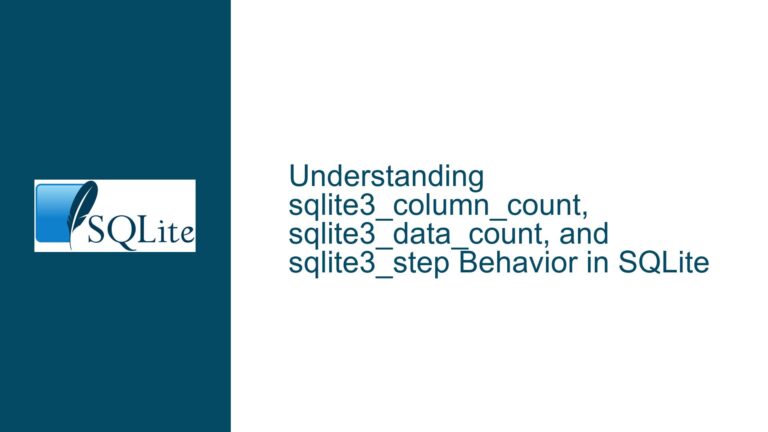Using SQLite RETURNING Clause as a Subquery: Limitations and Workarounds
SQLite RETURNING Clause Cannot Be Used as a Subquery
The SQLite RETURNING clause, introduced in version 3.35.0, allows users to retrieve the results of an INSERT, UPDATE, or DELETE statement directly within the same query. This feature is particularly useful for obtaining the values of newly inserted or modified rows without requiring a subsequent SELECT query. However, a common misconception is that the RETURNING clause can be used as a subquery or within a Common Table Expression (CTE) to chain multiple SQL operations. This is not the case, as SQLite explicitly restricts the use of Data Manipulation Language (DML) statements, including those with a RETURNING clause, within subqueries or CTEs.
The confusion arises because the RETURNING clause produces a result set similar to a SELECT statement, leading users to assume it can be treated as a table-valued expression. However, the RETURNING clause is tightly coupled with the DML operation it modifies and cannot be decoupled for use in nested queries. This limitation is not unique to SQLite; even PostgreSQL, which has a more mature implementation of the RETURNING clause, enforces similar restrictions. Specifically, PostgreSQL requires that any CTE containing a data-modifying statement must be at the top level of the query.
For example, consider the following SQLite schema and query attempt:
CREATE TABLE t0(
a INTEGER PRIMARY KEY,
b DATE DEFAULT CURRENT_TIMESTAMP,
c INTEGER
);
CREATE TABLE t0log (
whenCreated TEXT,
what INTEGER
);
-- Attempt to use RETURNING clause as a subquery
WITH stuffer AS (
INSERT INTO t0(c) VALUES(random()) RETURNING b, c
)
SELECT b, c FROM stuffer;
This query fails with the error: Error: near "INSERT": syntax error. The issue lies in the attempt to use the INSERT statement with a RETURNING clause inside a CTE, which SQLite does not support.
Misinterpretation of RETURNING Clause as a Table-Valued Expression
The core issue stems from the assumption that the RETURNING clause transforms a DML statement into a table-valued expression, akin to a SELECT statement or a table-valued function. While the RETURNING clause does produce a result set, it is not a standalone query and cannot be used in contexts where a subquery or CTE is expected. This limitation is rooted in the nature of DML operations, which modify the database state and are not idempotent. Allowing DML statements within subqueries could lead to unpredictable behavior, especially if the same DML operation were executed multiple times within a single query.
For instance, consider the following PostgreSQL example, which demonstrates the correct usage of the RETURNING clause within a CTE:
WITH stuffed AS (
INSERT INTO t0(a, b, c) VALUES(5, CURRENT_DATE, random()) RETURNING b, c
)
INSERT INTO t0log(whenCreated, what)
SELECT b, c FROM stuffed;
In this case, the WITH clause containing the INSERT statement is at the top level of the query, which PostgreSQL allows. However, if the WITH clause were nested within another query, PostgreSQL would reject it with the error: ERROR: WITH clause containing a data-modifying statement must be at the top level.
This behavior highlights a key distinction between SQLite and PostgreSQL: while both databases restrict the use of DML statements within subqueries, PostgreSQL provides a more flexible syntax for using RETURNING clauses at the top level of a query. SQLite, on the other hand, does not support this syntax at all, limiting the utility of the RETURNING clause in complex queries.
Implementing Workarounds for RETURNING Clause Limitations
Given the limitations of the RETURNING clause in SQLite, users must employ alternative strategies to achieve similar functionality. One common workaround is to use a temporary table to store the results of the RETURNING clause, which can then be used in subsequent queries. This approach involves executing the DML statement with the RETURNING clause, storing the results in a temporary table, and then using the temporary table in further operations.
For example, consider the following SQLite schema and query:
CREATE TABLE t0(
a INTEGER PRIMARY KEY,
b DATE DEFAULT CURRENT_TIMESTAMP,
c INTEGER
);
CREATE TABLE t0log (
whenCreated TEXT,
what INTEGER
);
-- Step 1: Create a temporary table to store RETURNING results
CREATE TEMP TABLE temp_results (
b DATE,
c INTEGER
);
-- Step 2: Execute the INSERT statement with RETURNING and store results
INSERT INTO temp_results (b, c)
INSERT INTO t0(c) VALUES(random()) RETURNING b, c;
-- Step 3: Use the temporary table in subsequent queries
INSERT INTO t0log (whenCreated, what)
SELECT b, c FROM temp_results;
-- Step 4: Clean up the temporary table
DROP TABLE temp_results;
This approach ensures that the results of the RETURNING clause are preserved and can be used in multiple queries without requiring client-side code or repeated DML operations. While this method introduces additional steps, it provides a reliable way to work around the limitations of the RETURNING clause in SQLite.
Another workaround involves using client-side code to execute the DML statement with the RETURNING clause and then use the results in subsequent queries. This approach is particularly useful in applications where the database operations are tightly integrated with application logic. For example, in Python using the sqlite3 module:
import sqlite3
# Connect to the SQLite database
conn = sqlite3.connect('example.db')
cursor = conn.cursor()
# Execute the INSERT statement with RETURNING
cursor.execute("INSERT INTO t0(c) VALUES(random()) RETURNING b, c")
result = cursor.fetchone()
# Use the results in subsequent queries
cursor.execute("INSERT INTO t0log (whenCreated, what) VALUES (?, ?)", result)
# Commit the transaction and close the connection
conn.commit()
conn.close()
This approach leverages the flexibility of client-side programming to handle the results of the RETURNING clause and perform additional database operations as needed. While it requires more code than a pure SQL solution, it provides greater control over the sequence of operations and can be adapted to complex use cases.
In conclusion, while the RETURNING clause in SQLite is a powerful feature for retrieving the results of DML operations, it cannot be used as a subquery or within a CTE. Users must employ workarounds such as temporary tables or client-side code to achieve similar functionality. Understanding these limitations and the available alternatives is crucial for effectively leveraging the RETURNING clause in SQLite.






